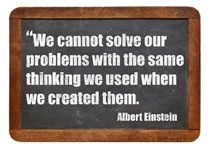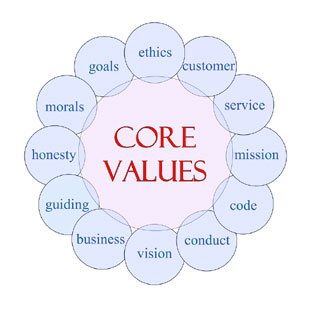Diagnosis: There is a Problem
 When you have a cold, it is easy to diagnose the problem from the symptoms you suffer. You cough, your head is stuffy and you have no energy. In business, there may be clues that a problem exists. However, diagnoses may not be as evident as what happens when we contract the common cold. The good news is that information abounds on solving problems. There are even problem solving models that act as a guide if one doesn’t know where to begin on solving a problem. So let’s look at some steps that can help solve business problems.
When you have a cold, it is easy to diagnose the problem from the symptoms you suffer. You cough, your head is stuffy and you have no energy. In business, there may be clues that a problem exists. However, diagnoses may not be as evident as what happens when we contract the common cold. The good news is that information abounds on solving problems. There are even problem solving models that act as a guide if one doesn’t know where to begin on solving a problem. So let’s look at some steps that can help solve business problems.
To begin, someone in the organization has to have a clue that a problem exits. Of course, more than likely the symptoms show up first, for example, poor sales, a lack of productivity, staffing problems and maybe even chaos. However, seeing the symptoms doesn’t always guarantee the diagnosis. Diagnosing business problems takes a few steps.
- Recognition that a problem exists is first. Leaders who put their heads in the sand and ignore problems are part of the problem and of course, this causes the problem to fester. Business failure can follow. Therefore, this is an important step.
 One constant in business is problems. There are two kinds of problems, the predictable and the unpredictable. Unpredictable problems are events such as earthquakes, illnesses, death, storms, and the like. Yet, even considering some of these, we all know that we have the possibility of becoming ill or running into weather that can change our plans especially if we are traveling and this is particularly true if we are traveling at certain times of the year. Having disaster plans in place can at least alleviate some of the consequences of major, unpredictable disasters. So how can businesses better anticipate other problems in order to be proactive in either preventing them or solving them more quickly and efficiently when they do occur? Here are some ideas to consider.
One constant in business is problems. There are two kinds of problems, the predictable and the unpredictable. Unpredictable problems are events such as earthquakes, illnesses, death, storms, and the like. Yet, even considering some of these, we all know that we have the possibility of becoming ill or running into weather that can change our plans especially if we are traveling and this is particularly true if we are traveling at certain times of the year. Having disaster plans in place can at least alleviate some of the consequences of major, unpredictable disasters. So how can businesses better anticipate other problems in order to be proactive in either preventing them or solving them more quickly and efficiently when they do occur? Here are some ideas to consider. Change can instill fear in the hearts of employees. A strong communication plan can help alleviate those fears. However, this presents a quandary for CEOs. Leadership often debates how much communication is too much. Given the chaos that a lack of communication can cause, over communicating is rarely a problem. This is especially true in the face of drastic organizational change such as mergers and acquisitions, leadership change or market shifts.
Change can instill fear in the hearts of employees. A strong communication plan can help alleviate those fears. However, this presents a quandary for CEOs. Leadership often debates how much communication is too much. Given the chaos that a lack of communication can cause, over communicating is rarely a problem. This is especially true in the face of drastic organizational change such as mergers and acquisitions, leadership change or market shifts. Opportunities will abound in 2014. As the title of this article indicates, it is about how we can make 2014 and every year a success by taking advantage of opportunities. Notice though, the title doesn’t have the word “new” in it. Why is this?
Opportunities will abound in 2014. As the title of this article indicates, it is about how we can make 2014 and every year a success by taking advantage of opportunities. Notice though, the title doesn’t have the word “new” in it. Why is this? The quote in the above title, is by the singer-songwriter, Bob Dylan. Chaos can be a friend in business as well. OK, when your head stops spinning, continue reading. CEOs start businesses because they are good at something. They think they can do something better than others. Or, they see a need in the market and fill that need. The point is that there are a myriad of reasons people start their own business. However, a new business is a world of struggle.
The quote in the above title, is by the singer-songwriter, Bob Dylan. Chaos can be a friend in business as well. OK, when your head stops spinning, continue reading. CEOs start businesses because they are good at something. They think they can do something better than others. Or, they see a need in the market and fill that need. The point is that there are a myriad of reasons people start their own business. However, a new business is a world of struggle. According to a recent study by the Society for Human Resource Management (SHRM), turnover varies by industry with the food & service industry along with the arts and entertainment industries and retail having the highest turnover with an average of 28% between them. Those having the lowest turnover are high-tech, government, associations and utilities. The average among these industries is only 9%. When calculating losses due to turnover, organizations must consider why they have turnover. For example, according to SHRM’s study, hospitality, arts/entertainment and retail may have seasonal or cyclical turnover. Some industries pay lower than others and the first offer of even a small increase in pay will lure employees away. If yours is an industry where the skill gap is growing, turnover can be a critical factor in organizational growth.
According to a recent study by the Society for Human Resource Management (SHRM), turnover varies by industry with the food & service industry along with the arts and entertainment industries and retail having the highest turnover with an average of 28% between them. Those having the lowest turnover are high-tech, government, associations and utilities. The average among these industries is only 9%. When calculating losses due to turnover, organizations must consider why they have turnover. For example, according to SHRM’s study, hospitality, arts/entertainment and retail may have seasonal or cyclical turnover. Some industries pay lower than others and the first offer of even a small increase in pay will lure employees away. If yours is an industry where the skill gap is growing, turnover can be a critical factor in organizational growth. There must be something in the water. The CEOs of two organizations, one a financial institution and one a marketing company conveyed to me that they do not believe in having mission and core value statements. Neither company is doing well. The financial institution has a fractured executive team due to a recent merger and the marketing company has been bleeding revenues heavily for the past two years. Coincidence? Maybe, maybe not. Mission and vision statements are valuable. Core values are priceless.
There must be something in the water. The CEOs of two organizations, one a financial institution and one a marketing company conveyed to me that they do not believe in having mission and core value statements. Neither company is doing well. The financial institution has a fractured executive team due to a recent merger and the marketing company has been bleeding revenues heavily for the past two years. Coincidence? Maybe, maybe not. Mission and vision statements are valuable. Core values are priceless. As a former corporate trainer, I know well that during tough economic times, the budget for training is often the first cut and the last to be restored. Many organizations do not see the value in having a training department, a trainer or even the relevance in hiring an outside trainer. Without training, your organization is likely to experience the following.
As a former corporate trainer, I know well that during tough economic times, the budget for training is often the first cut and the last to be restored. Many organizations do not see the value in having a training department, a trainer or even the relevance in hiring an outside trainer. Without training, your organization is likely to experience the following.